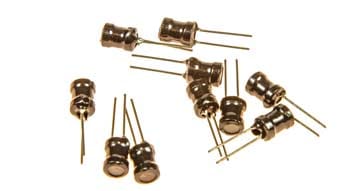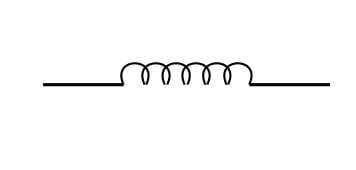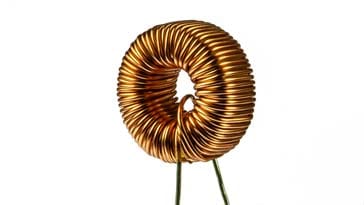What is an Inductor & Inductor Types
There are many different types of inductor, each with their own properties - understanding the properties of the different types is essential for selecting the right type for a circuit.
Inductors Includes:
Inductor types
Inductor specifications
How to select the right inductor
Ferrites
Ferrite beads
Transformers, types, applications
Inductors are an essential element of many circuit designs and there many types and styles that are used throughout the electronics industry.
Inductors perform a number of different functions within the various electronic circuit designs. Some types can be used for filtering and removing spikes on power lines, others are used within high performance filters. Others may be used within oscillators, and there are many other areas where inductors can be used.

As a result of this, there are many different types of inductor that can be obtained. Size, frequency, current, value, and many other factors means that there is a whole host of different types and forms of inductor.
In addition to this, there are conventional leaded types. Other larger ones may be fixed to a chassis, and int he other extreme, there are very small surface mount device inductors.
Inductor basics
When looking at what an inductor is and what different types of inductors are available, it is first worth understanding their function: what they are, the way they operate in an electronic circuit design and the different formats for the actual electronic components.
Although there are many different types of inductor, they all comply with the same basic laws of nature. Each inductor sets up a magnetic field around the conductor and the effect of this is that the inductor resists wants to resist any change in the flow of current.
If the source of the EMF is removed, then the inductor will create a back EMF to try to maintain the current. If an alternating signal is applied, then it will impede the flow of current as a result of the inductive reactance.

The basic parameters are used within the inductor, whatever type it is.
Note on Inductance:
Inductance is one of the basic factors that affect electrical circuits. Any wire or coil has a certain inductance associated with it which is caused by the magnetic field that is set up when the current flows. Energy is stored in the field, and the action of the coil is to exhibit a resistance to change of the current flow within the conductor or coil.
Read more about Inductance.
Although there is a level of inductance that is associated with a straight wire, the effect is enhanced of the wire is made into a coil. Te effect is further enhanced if a magnetic core is used for the inductor as well.
It is for this reason that many inductors have iron cores or ferrite cores. This considerably increases the level of inductance and means that the inductor will have a far greater effect for a given size.
Inductor cores
Inductors are normally made in the form of a coil. The reason for this is that the magnetic field is linked between the windings and builds up. As such an inductor with a sufficiently large inductance can be built up more easily.
As the permeability of the medium in which the coil is located has a major effect on the inductance, a core running down the centre of the coil is often used.
Cores such as iron, ferrite and other magnetic materials are used. These all significantly increase the level of inductance that can be obtained, but care has to be taken in the choice of core to ensure its performance is suitable for the power level, frequency and general application of the inductor.
Different inductor core types
Like other types of component such as the capacitor, there are very many different types of inductor. However it can be a little more difficult to exactly define the different types of inductor because the variety of inductor applications is so wide.
Although it is possible to define an inductor by its core material, this is not the only way in which they can be categorised. However for the basic definitions, this approach is used.
Air cored inductor: This type of inductor is normally used for RF applications where the level of inductance required is smaller. The fact that no core is used has several advantages: there is no loss within the core as air is lossless, and this results in a high level of Q, assuming the inductor or coil resistance is low. Against this the number of turns on the coil is larger to gain the same level of inductance and this may result in a physical increase in size.
Although this type of inductor is termed as an air cored inductor, often they may be wound on a former to keep the turns in place. Smaller coils may be truly air cored and have no former, but this can lead to aspects like changes in inductance with shock, vibration and the like.
When formers are used, they will be chosen from a material that does not conduct current - if it did conduct current then currents would be induced in the former this would destroy the action of the inductor. Accordingly insulating material are often chosen: plastic, ceramic and the like.
Iron cored inductor: Iron cores are normally used for high power and high inductance types of inductor. Some audio coils or chokes may use iron laminate. They are generally not widely used these days as a result of the cost and size.
When they are used, the core is laminated as this reduces the eddy currents and hence the loss
Ferrite cored inductor : Ferrite is one of the most widely used cores for a variety of types of inductor. Ferrite is a metal oxide ceramic based around a mixture of Ferric Oxide Fe2O3 and either manganese-zinc or nickel-zinc oxides which are extruded or pressed into the required shape.

Inductors on a toroidal ferrite former There are many different grades and types of ferrite used in these electronic components. They have different levels of permeability ad hence give different levels of increase in inductance. However they also introduce losses which increase with frequency, etc. SO the choice of the correct ferrite for the particular inductor required is all part of the choice if they are to be specifically wound for an RF design or other general circuit design.
- Iron power inductor: Another core that can be used in a variety of types of inductor is iron oxide. Like ferrite, this provides a considerable increase in the permeability, thereby enabling much higher inductance coils or inductors to be manufactured in a small space.
Different mechanical inductor types and applications
Inductors may also be categorised in terms of their mechanical construction. There are a number of different standard types by which inductors may be categorised:
- Bobbin based inductor: This type of inductor is would on a cylindrical bobbin. They may be designed for printed circuit board mounting, even surface mount of they may be much larger and mounted via some other mechanical means. Some older versions of these inductors may even be in a similar format to normal leaded resistors.
- Toroidal inductor: This form of inductor is wound on a toroid - a circular former. Ferrite is often used as the former as this increases the permeability of the core. The advantage of a toroid is that the toroid enables the magnetic flux to travel in a circle around the toroid and as a result the flux leakage is very low. The disadvantage with a toroidal inductor is that it requires a special winding machine is required to perform the manufacture as the wire has to be passed thought the toroid for each turn required.

Toroidal inductor - Multilayer ceramic inductor: This type of inductor is widely used for surface mount technology. The inductor is manufactured within a ferrite or more commonly a magnetic ceramic material. The coil is contained within the body of the ceramic and is presented to the external circuit on end caps in the same way as chip capacitors, etc.
- Film inductor: This form of inductor uses a film of conductor on a base material. The film is then etched or shaped to give the required conductor profile.
As it can be seen, there are a number of ways to classify the different types of inductor. Each of these electronic components has its own advantages, and it is therefore necessary to make a decision about the various options available when choosing an inductor for a particular application whether it is a low frequency circuit design, an RF design, or possible even EMC filters, or other electronic circuit design applications. Modern materials and technology has meant that the performance of inductors has increased and many more options are open to the circuit designer whether for RF applications, combatting EMI, or for power applications.
More Electronic Components:
Batteries
Capacitors
Connectors
Diodes
FET
Inductors
Memory types
Phototransistor
Quartz crystals
Relays
Resistors
RF connectors
Switches
Surface mount technology
Thyristor
Transformers
Transistor
Unijunction
Valves / Tubes
Return to Components menu . . .



